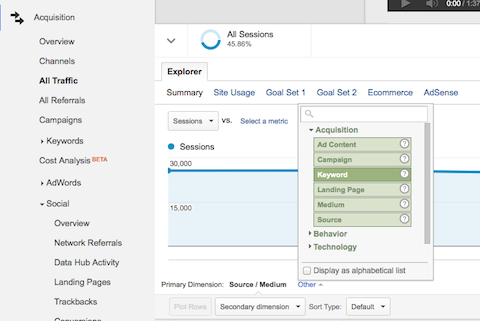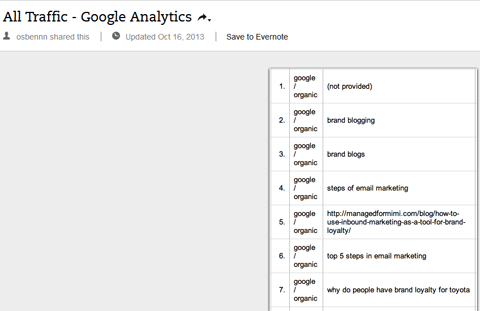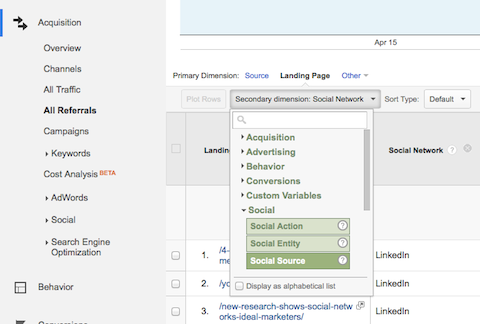 Do you want to learn more about your social media followers?
Do you want to learn more about your social media followers?
Have you created social media buyer personas?
You have to know your audience before you can serve them on social media.
In this article I'll show you how to create buyer personas for your social media audience using Google Analytics.
Why Buyer Personas?
A buyer persona goes beyond the definition of your target audience. You use them to create fictional identities that represent people within your target audience who share similarities.

With solid buyer personas informing your social media messaging, you can formulate content to better target your audience's interests and concerns. This will in turn make for a more engaged audience.
You can find a lot of information about your brand's online audience in the search data from your website's analytics.
Here's how to build buyer personas with Google Analytics.
#1: Research Your Website Traffic by Keyword
Begin by opening up Google Analytics, then go to Acquisition > All Traffic > Google/Organic and set the Secondary Dimension to Keyword.

This shows you the keyword searches that bring visitors to your site over a relatively long time period.
While the vast majority of the referring keywords will be “not provided,” the remaining data will be enough to get you started.

Copy the list into a spreadsheet so you can edit it.
#2: Find User Similarities in Search Traffic
Sort through the keywords in your spreadsheet and group them into themes or categories.
Get World-Class Marketing Training — All Year Long!
Are you facing doubt, uncertainty, or overwhelm? The Social Media Marketing Society can help.
Each month, you’ll receive training from trusted marketing experts, covering everything from AI to organic social marketing. When you join, you’ll also get immediate access to:
- A library of 100+ marketing trainings
- A community of like-minded marketers
- Monthly online community meetups
- Relevant news and trends updates
For example, if you market sporting goods, you might divide the keywords into categories such as clothing, footwear, balls and other equipment. You might also have categories for location-specific searches or sports-related questions.

Once you've created the categories, use them to determine what types of people are searching for these terms. Use the information you have to find the right questions to ask yourself to come up with accurate representations of your customers.
Make a list of personas such as “serious runners interested in buying sneakers locally for under $100,” or “beginners thinking about getting into mountain climbing.”
These are your rough buyer personas.
#3: Refine Buyer Personas by Social Channel
Now that your personas have been roughly defined, use the referral traffic data from Analytics to create prototypical audience members for each of your social media channels.
Back in Google Analytics, go to Acquisition > All Referrals. Choose Second Dimension and click on Landing Page.

Download this data into a spreadsheet and group the landing pages by social channel so you can determine which kind of content resonates best with the followers from each social media channel.

Discover Proven Marketing Strategies and Tips
Want to go even deeper with your marketing? Check out the Social Media Marketing Podcast! Publishing weekly since 2012, the Social Media Marketing Podcast helps you navigate the constantly changing marketing jungle, with expert interviews from marketing pros.
But don’t let the name fool you. This show is about a lot more than just social media marketing. With over 600 episodes and millions of downloads each year, this show has been a trusted source for marketers for well over a decade.

The patterns and preferences you find will help you create a sharpened buyer persona for each social network your brand manages a presence on.
For example, a restaurant might find that Facebook refers more people looking for reservations and that Twitter refers more people looking for daily specials.
With that information, the restaurant can install a custom reservations tab on their Facebook page to better serve their existing customers and begin promoting their lunch specials on Twitter to bring in new customers.
#4: Fill Out Social Details for Your Personas
You can take things a step further and beef up your personas by looking at how your fans and followers on social media describe themselves to see if you can spot any patterns.
Twitter's native Analytics provides relevant insights, especially from the Your Followers Also Follow and Interests sections.

Followerwonk will pull common keywords from your followers' Twitter bios.
On Facebook, you can use Graph Search to learn more about the interests of your fans by running queries such as “pages liked by fans of [your business page]”.
Examine the smaller social media sites your audience frequents—for example, Behance, Empire Avenue, TripAdvisor, OpenForum or Quora—to help you further narrow down their interests.
For example, people who spend time on Q&A sites are likely to enjoy information written by experts, while those who like photo sharing social networks will look for content rich in images.

The more information you compile for your buyer personas, the more personal you can make your messaging, content and outreach.
Over to You
Follow the steps above and you'll learn more about your social media audiences and maximize the business impact of your social marketing.
Once you know what your social media audience searches for, you can adjust the content you create and your messaging so they match the interests of each social media channel's buyer persona.
Better understanding through data analysis is what lets you do this, and the potential rewards are huge. When the members of your community feel that you understand them and have a knack for addressing their needs, they'll pay more attention to what you have to say. They'll also interact more with your posts. This means more organic reach to like-minded people, which will drive more business.
Use the information available to you on Google Analytics to learn more about your audience and serve your customers better on social media.
What do you think? What tools and techniques are you using to learn more about your social media audience? Share your suggestions and comments in the box below.
Images from iStockPhoto.
Attention Agency Owners, Brand Marketers, and Consultants

Introducing the Marketing Agency Show–our newest podcast designed to explore the struggles of agency marketers.
Join show host and agency owner, Brooke Sellas, as she interviews agency marketers and digs deep into their biggest challenges. Explore topics like navigating rough economic times, leveraging AI, service diversification, client acquisition, and much more.
Just pull up your favorite podcast app, search for Marketing Agency Show and start listening. Or click the button below for more information.

